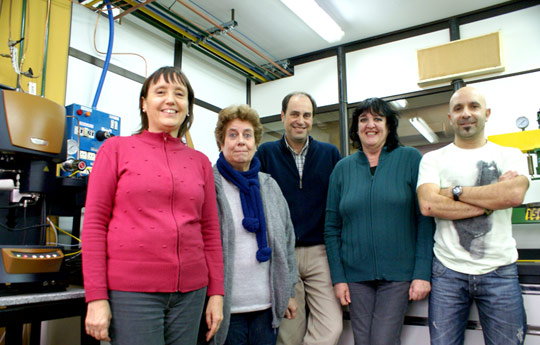AGRARIAN, ENGINEERING AND MATERIAL SCIENCES
Packaging: it’s what’s on the outside that counts
Scientists at the PLAPIQUI research into the development and improvement of plastic films for food packaging.
Preserving fruit and vegetables demands special care because, once collected, they continue ‘breathing’, resulting in quick deterioration. The proper manipulation of vegetables through a suitable selection of the packaging and the storage conditions extend the shelf life and help maintain the freshness and the organoleptic characteristics.
Since 90s, researchers of the Planta Piloto de Ingeniería Química -PLAPIQUI, CONICET-UNS- [Chemical Engineering Pilot Plant] have worked on the design of polymeric films to produce packages mainly for the food industry. “We noticed that companies promoted innovations. There are many products that are exported and use or could use modified atmosphere packaging technologies. For this reason, it would be very interesting for us to have national production material. With the knowledge our team generated we obtained specific equipment to work on the development of new materials”, Graciela Goizueta, principal professional of the CONICET at the Plant and coordinator of the Packaging area, states.
The higher the respiration rate in the packaging, the faster the product rots. That is why it is advisable to reduce the process so as to maintain its freshness. For this reason, the Modified Atmosphere Packaging (MAP) technique is used because it eliminates the air inside the package and replaces the air with a gas or a mixture of gases, carbon dioxide (CO2) and nitrogen, in general. The proportions of each one depends on the type of food to pack and in most cases CO2 rich and poor in oxygen environments are required because it is on these two that the product respiration rate is reduced.
Goizueta explains that the team is currently studying polyolefin-based materials. To regulate the permeability of the gases and adapt its mechanical properties to achieve higher flexibility, for instance, polyolefin elastomers are incorporated into the polypropylene, which is normally used for packaging production. “This kind of film is not available at the local markets, they have to be imported and for this reason we try to use the polypropylene as main polymer because of its low cost and the fact that it is locally produced. Nevertheless, as it is not very permeable to oxygen and water vapour, we modified it”, the researcher adds.
Likewise, the engineer remarks the fact that other dry and greasy products such as snacks demand packaging that work as a barrier against oxygen to avoid its rottenness. For this reason, the researchers study polypropylene coated with natural polymers such as gelatine to generate a controlled atmosphere. This process is known as coating and it involves taking a base material and adding a different layer above it.
During the first stage, the scientists produced the gelatine films laminated with different compounds until they obtained films with good mechanical, flexible and transparent properties. Then, they tasted its adhesion to the substrate and measure the properties of the barrier.
For his part, Daniel Ercoli, principal professional of the CONICET at the PLAPIQUI, explains that the materials of commercial packaging have many layers and they are produced by coextrusion, that is to say, through an extruder, a machine that provides different plastics that then are combined to form bonded laminate adhesives. “We try to develop mixtures of materials so as to get one layer working as a barrier and to have easier manufacturing”, he states.
Ercoli also comments that they are studying the poly(lactic acid) (PLA), a bioplastic that is not produced in the country currently and it is used as an alternative for traditional films. It is obtained from the fermentation of corn or potato starch with Lactic acid bacteria and it is biodegradable. In the future, they are going to develop active packaging using gelatin as brackets for additives such as additives as bactericides and antioxidants that can migrate to packaged food.
Finally, Goizueta highlights that all studies focus on understanding the structure and properties of the polymers, and with this knowledge better results can be obtained. “We are constantly providing technical assistance to companies that process plastic to produce films and the converter ones, which are the ones that print, and laminate them with other materials and form the structure of the packaging. We advise on quality issues or to product failures. Furthermore, the team provides information to different industries of other sectors that use imported plastic material and ask us for support regarding alternatives to produce them locally”, the researcher concludes.
- By Cecilia Leone.
